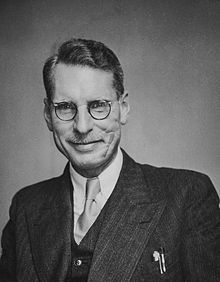Ladislaus von Rabcewicz
Ladislaus von Rabcewicz (born June 12, 1893 in St. Kunigund near Maribor (German: Marburg an der Drau), then Austria-Hungary , now Slovenia; † December 19, 1975 ) was an Austrian university professor and pioneer of tunneling . He played a key role in the development of the New Austrian Tunneling Method , a tunneling method that is widespread today.
Life and professional history
Ladislaus von Rabcewicz, who grew up the son of a landowner, graduated from high school in Graz . He then studied civil engineering at the Technical University in Graz and Vienna . During his studies he became a member of the Graz academic fraternity Arminia. However, his studies were interrupted by the First World War, where he had to join a sapper battalion. During the war he became an officer candidate and later a military official in Poland .
In June 1918 he was able to finish his studies. In the same year he married Elisabeth Wurmb, the daughter of Karl Wurmb , the builder of the Tauern Railway .
Professionally, he began in Styria with railway routing and flood protection structures . He spent the following years on Java, where he worked for the Dutch-Indian State Railways. In 1924 he returned to his homeland, where he worked on the Pinkatalbahn and the Tiroler Zugspitzbahn . He experienced his baptism of fire in the tunnel construction , which later became his main area, while working on the power plant near Reutte , which is located in a geologically difficult area.
From 1928 to 1931 he was the construction manager of a railway in southern Anatolia. He then took part in the construction of the Grossglockner High Alpine Road .
In the following years he was abroad again, this time in Iran to build the Trans-Iranian Railway . In the construction lot, which comprised 120 km, 75 tunnels with a total length of 20 km had to be built in partly difficult terrain. So he worked his way up to the position of chief of railway maintenance of the Persian State Railways.
During this time he realized how far apart theory and practice in tunneling diverged. He also kept in constant contact with Karl von Terzaghi, who taught soil mechanics in Vienna .
In 1938 he became chief engineer in a German construction company and was entrusted with planning a Rhine tunnel in Cologne and a tunnel for the Reichsautobahn near Swinoujscie . The lock construction of the Danube power plant Ybbs-Persenbeug also fell into his activity.
From 1940 until the end of the war he was a full professor for railways at the Technical University in Vienna . He was also a consultant for tunnels for the Todt Organization . The construction of the railway from Fauske to Kirkenes in Norway should be mentioned in particular . However, the project got stuck in the planning phase. The construction of the Loibl Tunnel between Carinthia and Slovenia began at that time, but also stopped when the war ended.
In the post-war period he worked both as an independent consultant and as a consultant for large underground construction companies. Examples include the reconstruction of the Semmering Tunnel or the reconstruction of the Präbichl Tunnel in his homeland , but also abroad the second largest cavern in the world, the Forcacava or the sewer of the Aswan power plant .
In 1951 he did his doctorate in technical sciences at the Graz University of Technology.
From 1956 to 1958 he worked as a UN advisor on tunneling in Venezuela . For the first time, he consistently applied the knowledge he had researched to various tunnel constructions in the course of motorway and railway construction, so that these tunnels can be described as the first to be constructed using the new tunneling method.
Since 1958 he has worked as a freelance civil engineer worldwide. After returning from Venezuela, he began to work more and more in the then still small Salzburg circle , to which Leopold Müller and Franz Pacher , for example, belonged. With these two he also helped the New Austrian Tunneling Method to become a building standard that is often used today.
He applied for a patent for this tunnel construction in 1948, which was accepted in 1949. With the experience that the development was continuing rapidly, he soon gave up the patent. He always endeavored to pass on his knowledge comprehensively.
Seven days after being honored with the Wilhelm Exner Medal , he suddenly died on December 19, 1975. He is buried in his last closer home at the forest cemetery of St. Gertrauden near Mauterndorf in Salzburg.
In his life he was significantly involved in more than 200 km of tunnel construction worldwide. Two of his grandchildren are also tunneling engineers, one of whom is a full professor in Graz.
Works
- Rock pressure and tunnel construction , 1944
- a total of 49 publications
Awards
- 1965 Honorary doctorate from the Graz University of Technology
- 1973 Johann Joseph Ritter von Prechtl Medal
- 1975 Honorary doctorate from the Montan University Leoben
- 1975 Wilhelm Exner Medal
literature
- Dipl.-Ing. Erich Hackl, Ladislaus von Rabcewicz in Felsbau 11 (1993), No. 5, 220ff
Web links
- Entry about Ladislaus von Rabcewicz in the database of the Wilhelm Exner Medal Foundation .
- Photo by Rabcewicz on the website of IGT Geotechnik und Tunnelbau ZT GmbH
| personal data | |
|---|---|
| SURNAME | Rabcewicz, Ladislaus von |
| ALTERNATIVE NAMES | Ladislaus von Rabcewicz-Zubkowski |
| BRIEF DESCRIPTION | Austrian tunnel construction pioneer |
| DATE OF BIRTH | June 12, 1893 |
| PLACE OF BIRTH | St. Kunigund near Marburg , Slovenia |
| DATE OF DEATH | 19th December 1975 |
